coolant Oldsmobile Achieva 1998 s User Guide
[x] Cancel search | Manufacturer: OLDSMOBILE, Model Year: 1998, Model line: Achieva, Model: Oldsmobile Achieva 1998Pages: 356, PDF Size: 18.04 MB
Page 207 of 356
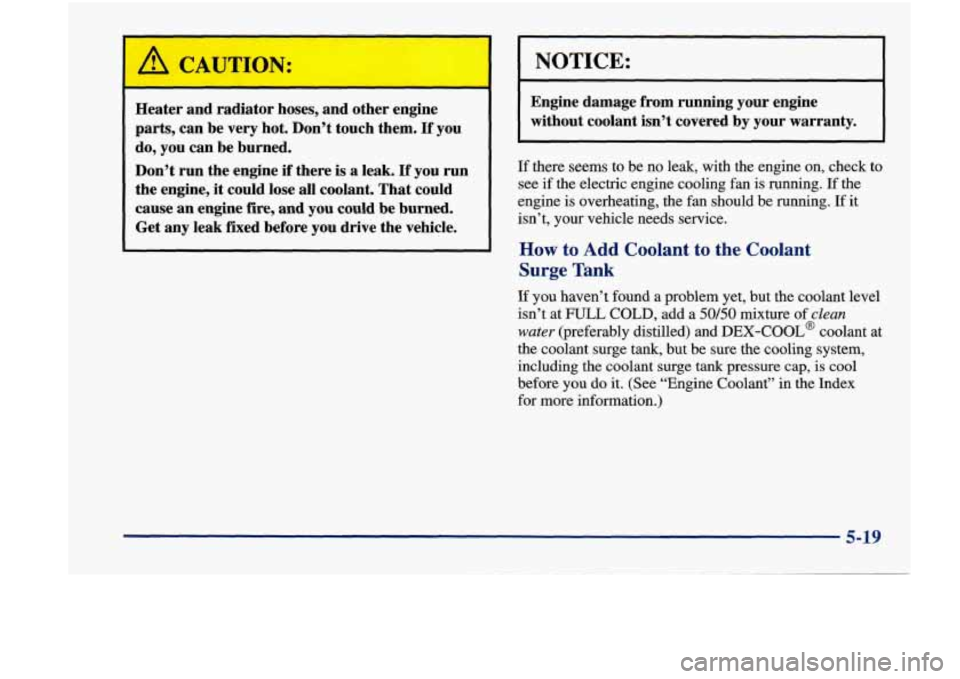
, ,- CAUTION:
~ Heater and radiator hoses, and other engine
1 parts, can be very hot. Don’t touch them. If you
l do, you can be burned.
Don’t run the engine
if there is a leak. If you run
1 the engine, it could lose all coolant. That could
cause an engine
fire, and you could be burned.
’ Get any leak fixed before you drive the vehicle.
NOTICE:
Engine damage from running your engine
without coolant isn’t covered by your warranty.
.
If there seems to be no leak, with the engine on, check to
see if the electric engine cooling fan is running.
If the
engine is overheating, the fan should be running.
If it
isn’t, your vehicle needs service.
How to Add Coolant to the Coolant
Surge Tank
If you haven’t found a problem yet, but the coolant level
isn’t at
FULL COLD, add a 50/50 mixture of clean
water (preferably distilled) and DEX-COOL@ coolant at
the coolant surge tank, but be sure the cooling system,
including the coolant surge
tank pressure cap, is cool
before you do it. (See “Engine Coolant” in the Index
for more information.)
5-19
Page 208 of 356
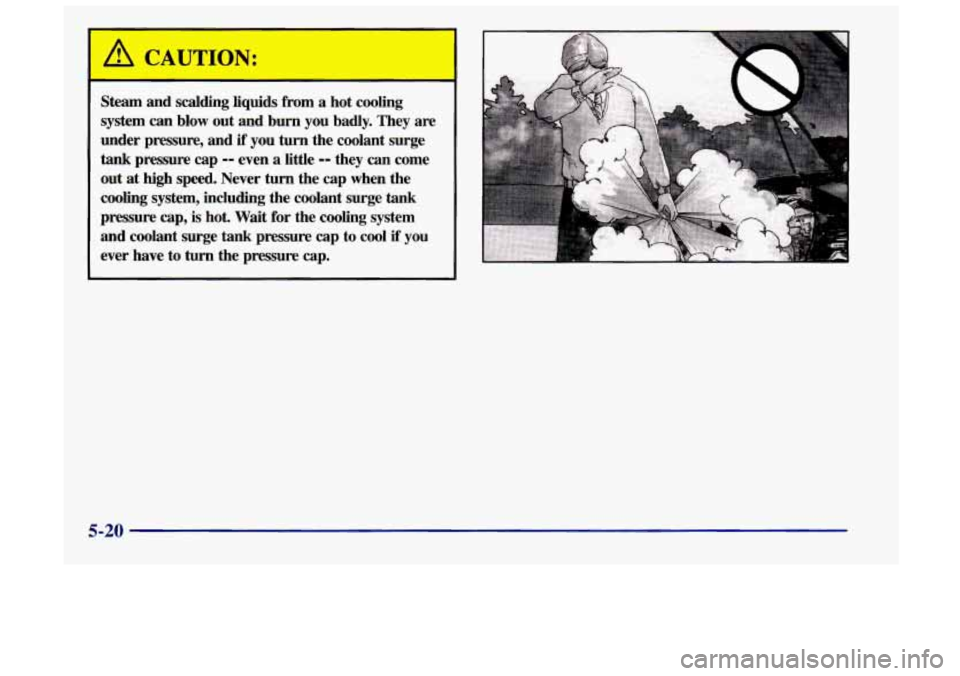
Steam and scalding liquids from a hot cooling
system can blow out and burn you badly. They are
under pressure, and
if you turn the coolant surge
tank pressure cap -- even a little -- they can come
out
at high speed. Never turn the cap when the
cooling system, including the coolant surge
tank
pressure cap, is hot. Wait for the cooling system
and coolant surge
tank pressure cap to cool if you
ever have
to turn the pressure cap.
5-20
Page 209 of 356
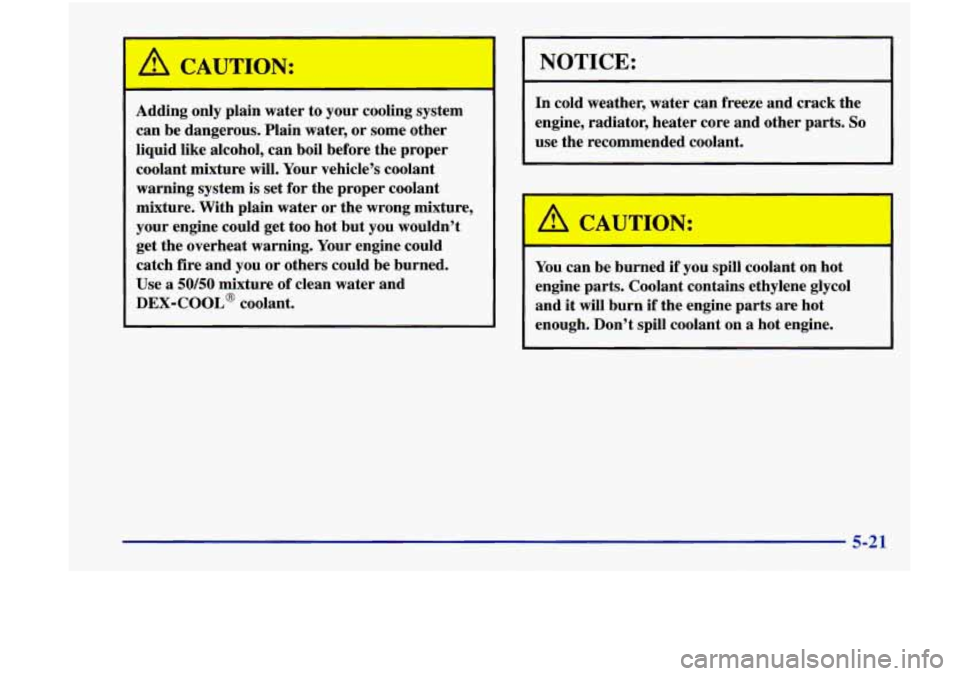
A CAUTION:
Adding only plain water to your cooling system
can be dangerous. Plain
water, or some other
liquid like alcohol, can boil before the proper
coolant mixture will. Your vehicle’s coolant
warning system is set for the proper coolant
mixture. With plain water or the wrong mixture,
your engine could get too hot but you wouldn’t
get the overheat warning. Your engine could
catch fire and you or others could be burned.
Use
a 50/50 mixture of clean water and
DEX-COOL@ coolant.
I NOTICE:
In cold weather, water can freeze and crack the
engine, radiator, heater core and other parts.
So
use the recommended coolant.
A CAUTION:
~
You can be burned if you spill coolant on hot
engine parts. Coolant contains ethylene glycol
and it will burn
if the engine parts are hot
enough. Don’t spill coolant on a hot engine.
5-21
Page 210 of 356
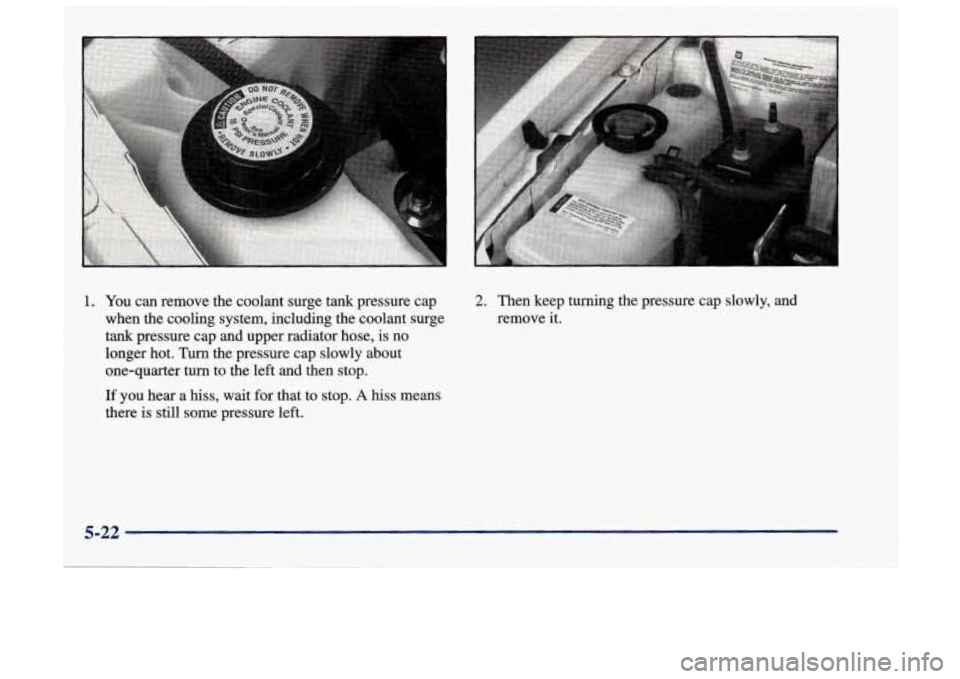
1. You can remove the coolant surge tank pressure cap
when the cooling system, including the coolant surge
tank pressure cap and upper radiator hose, is no
longer hot. Turn the pressure cap slowly about
one-quarter turn to the left and then stop.
If you hear a hiss, wait for that to stop. A hiss means
there is still some pressure left.
5-22
Page 211 of 356
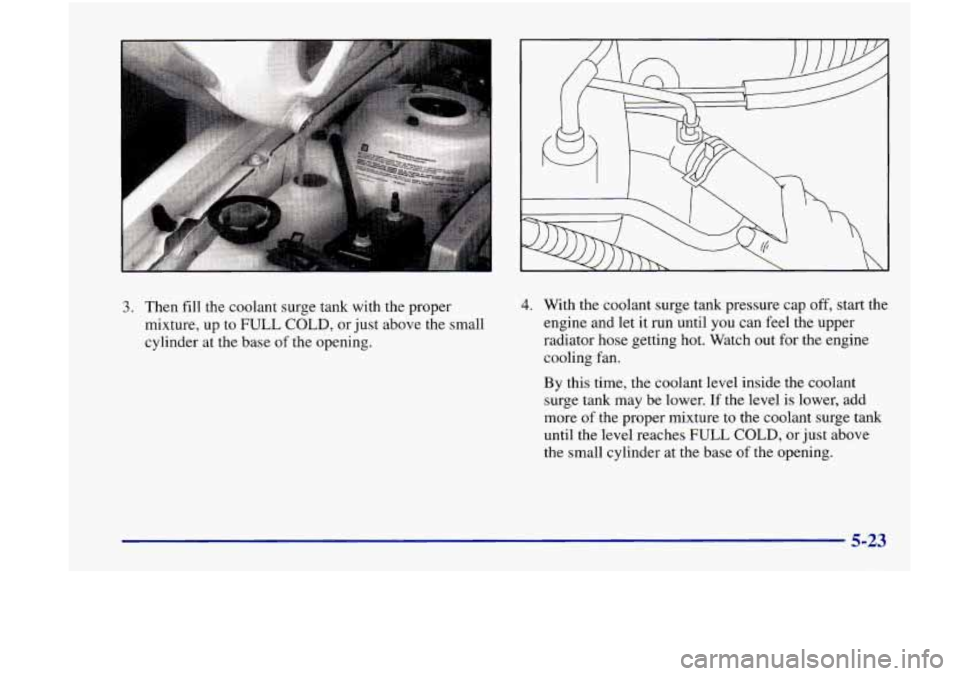
3. Then fill the coolant surge tank with the proper
mixture, up
to FULL COLD, or just above the small
cylinder at the base
of the opening.
4. With the coolant surge tank pressure cap off, start the
engine and let it run until you can feel the upper
radiator hose getting hot. Watch out for the engine
cooling fan.
By this time, the coolant level inside the coolant
surge tank may be lower.
If the level is lower, add
more
of the proper mixture to the coolant surge tank
until the level reaches
FULL COLD, or just above
the small cylinder at the base of the opening.
5-23
Page 212 of 356

5. Then replace the pressure cap. Be sure the pressure
Check the level in the surge tank when the cooling
system has cooled down. If the coolant isn’t at the
proper level, repeat Steps
1 to 3 and reinstall the
pressure cap or
see your retailer.
cap
is tight.
If a Tire Goes Flat
It’s
unusual for a tire to “blow out” while you’re driving,
especially if you maintain your tires properly. If
air goes
out of a tire, it’s much more likely to leak out slowly.
But
if you should ever have a “blowout,” here are a few
tips about what to expect and what to do:
If a front tire fails, the flat tire will create a drag that
pulls the vehicle toward that side. Take your foot off the
accelerator pedal and grip the steering wheel firmly.
Steer to maintain lane position, and then gently brake to
a stop well out of the traffic lane.
A rear blowout, particularly on a curve, acts much like a
skid and may require the same correction you’d use in a
skid. In any rear blowout, remove your foot from the
accelerator pedal. Get the vehicle under control by
steering the way you want the vehicle to go. It may be
very bumpy and noisy, but you can still steer. Gently
brake to a stop
-- well off the road if possible.
If a tire goes flat, the next part shows how to use your
jacking equipment to change a flat tire safely.
5-24
Page 229 of 356
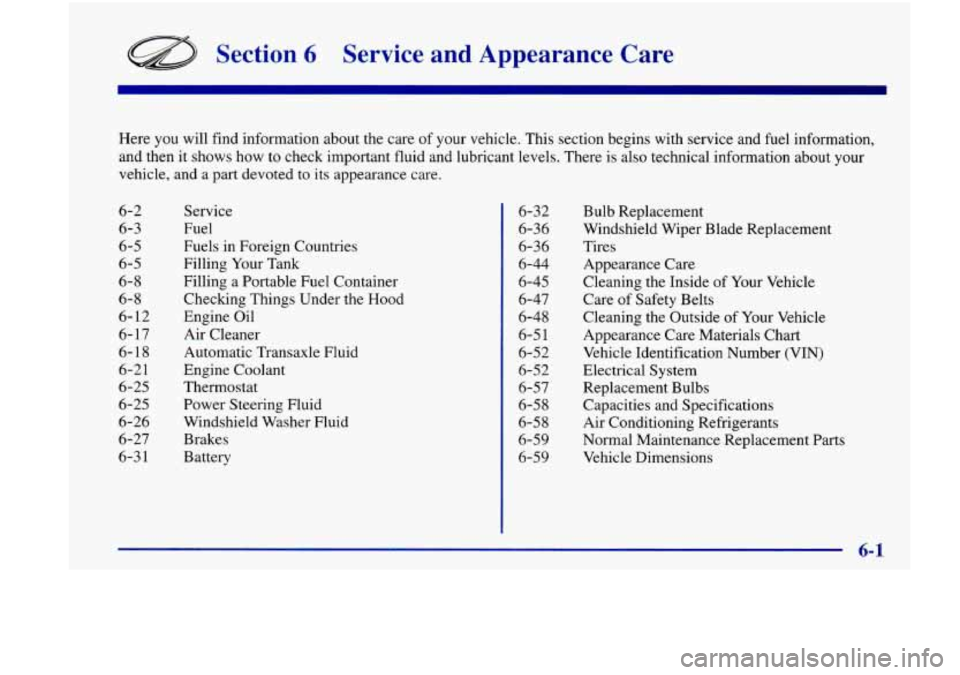
Section 6 Service and Appearance Care
Here you will find information about the care of your vehicle. This section begins with service and fuel information,
and then it shows
how to check important fluid and lubricant levels. There is also technical information about your
vehicle, and a part devoted to its appearance care.
6-2
6-3
6-5
6-5
6-8
6-8
6-
12
6- 17
6-18
6-2 1
6-25
6-25
6-26
6-27
6-3
1
Service
Fuel
Fuels in Foreign Countries
Filling Your Tank
Filling a Portable Fuel Container
Checking Things Under the Hood
Engine Oil
Air Cleaner Automatic Transaxle Fluid
Engine Coolant
Thermostat Power Steering Fluid
Windshield Washer Fluid Brakes
Battery 6-32
6-3 6 6-36
6-44
6-45
6-47
6-48
6-5
1
6-52
6-52
6-57
6-58
6-58
6-59
6-59 Bulb Replacement
Windshield Wiper
Blade Replacement
Tires
Appearance Care
Cleaning the Inside of Your Vehicle
Care
of Safety Belts
Cleaning the Outside
of Your Vehicle
Appearance
Care Materials Chart
Vehicle Identification Number (VIN)
Electrical System
Replacement Bulbs
Capacities and Specifications
Air Conditioning Refrigerants
Normal Maintenance Replacement Parts Vehicle Dimensions
Page 236 of 356
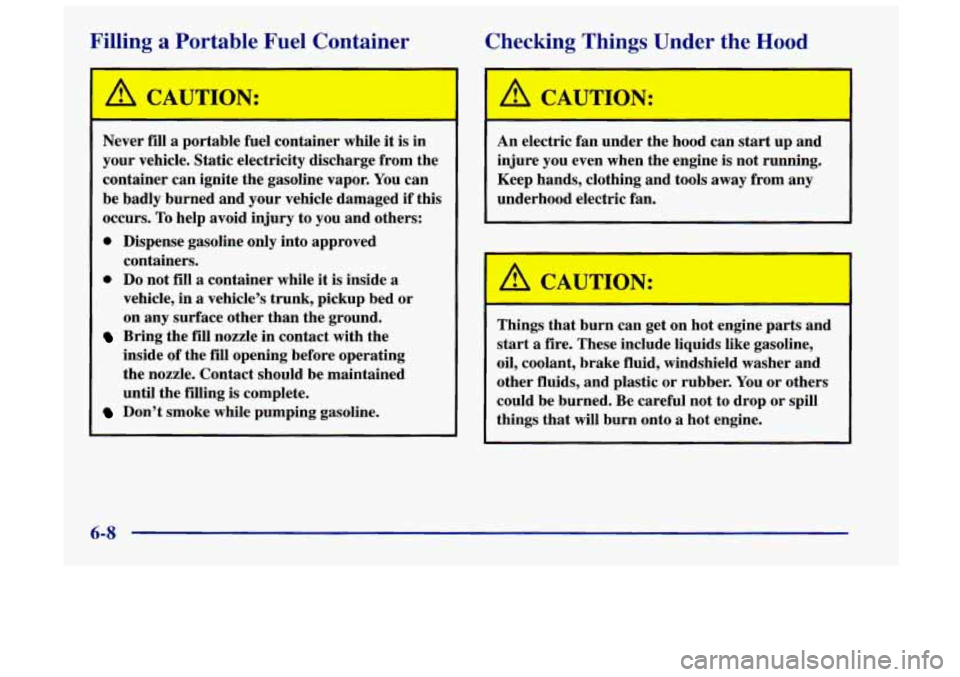
Filling a Portable Fuel Container
Never fill a portable fuel container while it is in
your vehicle. Static electricity discharge from the
container can ignite the gasoline vapor. You can
be badly burned and your vehicle damaged if this
occurs.
To help avoid injury to you and others:
0 Dispense gasoline only into approved
containers.
0 Do not fill a container while it is inside a
vehicle, in
a vehicle's trunk, pickup bed or
on any surface other than the ground.
inside of the fill opening before operating
the nozzle. Contact should be maintained
until the filling
is complete.
Bring the fill nozzle in contact with the
Don't smoke while pumping gasoline.
Checking Things Under the Hood
A "P 3N:
&I - --
An electric fan under the hood can start up and
injure you even when the engine is not running.
Keep hands, clothing and tools away from any
underhood electric fan.
Things that burn can get on hot engine parts and
start a fire. These include liquids like gasoline,
oil, coolant, brake fluid, windshield washer and
other fluids, and plastic or rubber. You or others
could be burned. Be careful not to drop or spill
things that will burn onto
a hot engine.
6-8
Page 238 of 356
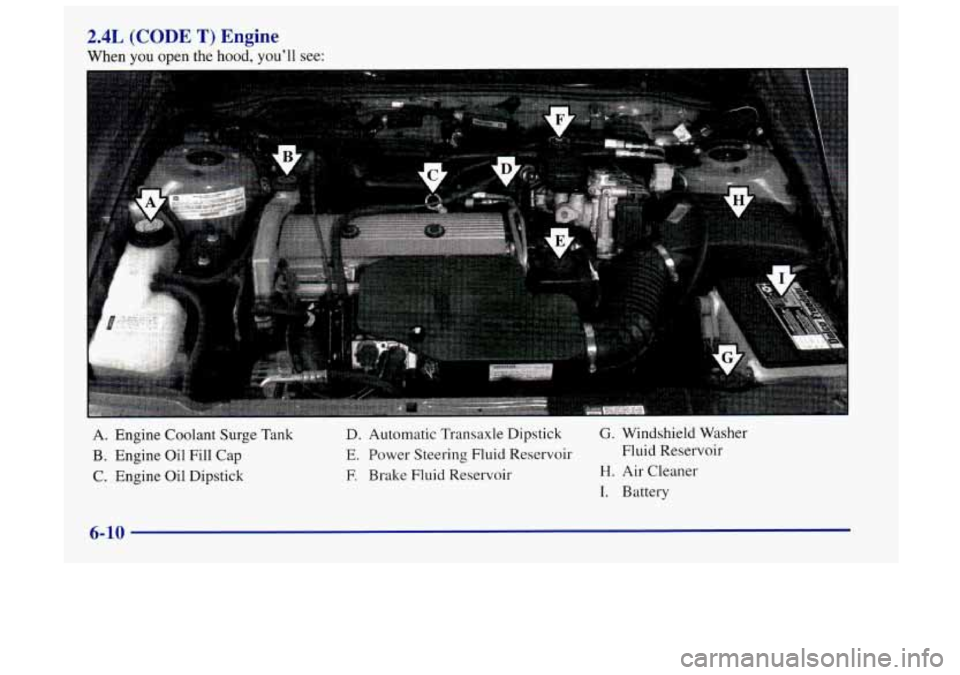
2.4L (CODE T) Engine
When you open the hood, you’ll see:
A. Engine Coolant Surge Tank
B. Engine Oil Fill Cap
C. Engine Oil Dipstick
D. Automatic Transaxle Dipstick
E. Power Steering Fluid Reservoir
E Brake Fluid Reservoir
G. Windshield Washer
Fluid Reservoir
H. Air Cleaner
1. Battery
Page 239 of 356
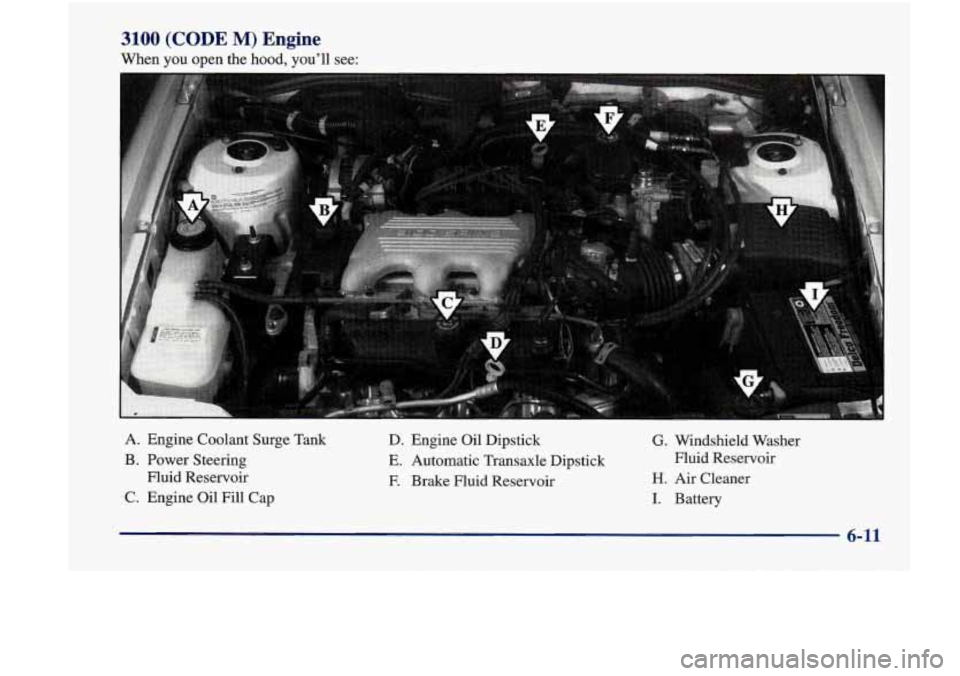
3100 (CODE M) Engine
When you open the hood, you’ll see:
I
A. Engine Coolant Surge Tank
B. Power Steering Fluid Reservoir
C. Engine Oil Fill Cap D. Engine
Oil Dipstick
E. Automatic Transaxle Dipstick
F. Brake Fluid Reservoir
G. Windshield Washer
Fluid Reservoir
H. Air Cleaner
I. Battery
6-11